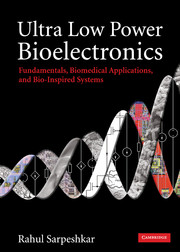Book contents
- Frontmatter
- Contents
- Acknowledgements
- Section I Foundations
- Section II Low-power analog and biomedical circuits
- 11 Low-power transimpedance amplifiers and photoreceptors
- 12 Low-power transconductance amplifiers and scaling laws for power in analog circuits
- 13 Low-power filters and resonators
- 14 Low-power current-mode circuits
- 15 Ultra-low-power and neuron-inspired analog-to-digital conversion for biomedical systems
- Section III Low-power RF and energy-harvesting circuits for biomedical systems
- Section IV Biomedical electronic systems
- Section V Principles for ultra-low-power analog and digital design
- Section VI Bio-inspired systems
- Section VII Energy sources
- Bibliography
- Index
- Epilogue
- References
14 - Low-power current-mode circuits
from Section II - Low-power analog and biomedical circuits
Published online by Cambridge University Press: 02 December 2010
- Frontmatter
- Contents
- Acknowledgements
- Section I Foundations
- Section II Low-power analog and biomedical circuits
- 11 Low-power transimpedance amplifiers and photoreceptors
- 12 Low-power transconductance amplifiers and scaling laws for power in analog circuits
- 13 Low-power filters and resonators
- 14 Low-power current-mode circuits
- 15 Ultra-low-power and neuron-inspired analog-to-digital conversion for biomedical systems
- Section III Low-power RF and energy-harvesting circuits for biomedical systems
- Section IV Biomedical electronic systems
- Section V Principles for ultra-low-power analog and digital design
- Section VI Bio-inspired systems
- Section VII Energy sources
- Bibliography
- Index
- Epilogue
- References
Summary
We aren't making the best products just because some customer suggested them to us, or even assured us of big orders, but because we have a passion to bring some art, in which we have a large personal investment, to the pinnacle of perfection.
Barrie GilbertIn this chapter, we shall discuss circuits that use current inputs and current outputs to create static and dynamic linear and nonlinear systems. Current-mode circuits can operate at low power-supply voltages and over a wide range of currents with exponential subthreshold or bipolar transistors. For reasons that will become clear at the end of the chapter, current-mode signal processing implemented with exponential devices is also often termed log-domain signal processing.
We shall begin by discussing static translinear circuits, which were invented by Barrie Gilbert in the bipolar-circuit domain and that are easily generalized to the subthreshold-MOS domain. Then, we shall discuss circuits for constructing linear current-mode dynamical systems analogous to Gm − C filters in the voltage domain, which were invented and developed by Seevinck, Tsividis, Frey, Toumazou, Andreou, Vittoz, Minch and others. We shall present gain-control techniques for achieving a nearly constant signal-to-noise ratio over a wide dynamic range of inputs, developed by Tsividis for use in linear current-mode input-output systems. Such adaptive techniques separate signal-to-noise ratio (SNR) and dynamic-range variables enabling low-power operation over a wide dynamic range of inputs.
Information
- Type
- Chapter
- Information
- Ultra Low Power BioelectronicsFundamentals, Biomedical Applications, and Bio-Inspired Systems, pp. 354 - 384Publisher: Cambridge University PressPrint publication year: 2010
